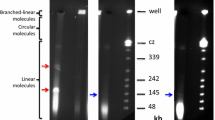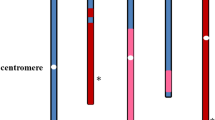Abstract
There maize nuclear DNA fragments were isolated on the basis of their ability to confer replication on chimeric plasmids in yeast. These Eco RI fragments of 2.5, 2.8 and 5.5 kb are repeated elements within the maize genome. The 2.5 and 2.8 kb fragments represent a family of elements repeated 11 000 times in the maize haploid genome, while the 5.5 kb fragment is part of another family of 28 000 elements. These fragments were subcloned to further define the unique region of ARS activity. The sequence of each 550–650 bp ARS subclone is reported here, and compared to the flanking regions which do not show ARS activity. The ARS elements are 65–70% A+T as compared to 50–55% for the maize genome as a whole. There is approximately 15% sequence divergence, as well as variation of ARS efficiency, among family members. ARS subclones contain the proposed yeast consensus sequence.
Similar content being viewed by others
References
Berlani RE, Davis RW, Walbot V: Genomic organization of two families of highly repeated nuclear DNA sequences of maize selected for autonomous replicating activity in yeast. Plant Mol Biol 11: 161–172 (1988).
Broach JR, Li YY, Feldman J, Jayaram M, Abraham J, Nasmyth KA, Hicks JB: Localization and sequence analysis of yeast origins of DNA replication. Cold Spring Harbor Symp Quant Biol 47: 1165–1173 (1982).
Brown PC, Tlsty TD, Schmike RT: Enhancement of methotrexate resistance and dihydrofolate reductase gene amplification by treatment of mouse 3T6 cells with hydroxyurea. Mol Cell Biol 3: 1097–1107 (1983).
Celniker SE, Campbell JL: Yeast DNA replication in vitro: Initiation and elongation events mimic in vivo processes. Cell 31: 201–213 (1982).
Celniker SE, Sweder D, Srienc F, Bailey JE, Campbell JL: Deletion mutations affecting autonomously replicating sequence ARS1 in Saccharomyces cerevisiae. Mol Cell Biol 4: 2455–2466 (1982).
Davis RW, Botstein D, Roth JR: A Manual for Genetic Engineering, Advanced Bacterial Genetics. Cold Spring Harbor Laboratory, Cold Spring Harbor, NY (1980).
Fangman W, Rice RH, Chlebowitz-Sledziewska E: ARS replication during the yeast S phase. Cell 32: 831–838 (1983).
Hake S, Walbot V: The genome of Zea mays, its organization and homology to related grasses. Chromosoma (Berl.) 79: 251–270 (1980).
Hieter P, Mann C, Snyder M, Davis RW: Mitotic stability of yeast chromosomes: a colony color assay that measures nondisjunction and chromosome loss. Cell 40: 381–392 (1985).
Kearsey S: Structural requirements for the function of a yeast chromosomal replicator. Cell 37: 299–307 (1984).
Kunkel GR, Martinson HG: Nucleosomes will not form on double stranded RNA or over poly(dA) poly(dT) tracts in recombinant DNA. Nucl Acids Res 9: 6869–6888 (1981).
Marunouchi T, Hosoya H: Isolation of an autonomously replicating sequence (ARS) from satellite DNA of Drosophila melanogaster. Mol Gen Genet 196: 258–265 (1984).
Maxam AM, Gilbert W: Sequencing of end labeled DNA with base specific chemical cleavage. Methods in Enzymology 65: 499–560 (1980).
Messing J: New M13 vectors for cloning. In: Wu R, Grossman L, Moldave K (eds) Methods in Enzymology 101 (Part C) Recombinant DNA Techniques, pp. 20–78. Academic Press, New York (1983).
Ohtani T, Uchimiya H, Kato A, Harada H, Sugita M, Sugiura M: Location and nucleotide sequence of a tobacco chloroplast DNA segment capable of replication in yeast. Mol Gen Genet 195: 1–4 (1984).
Ohtani T, Kiyokawa S, Ohgawara T, Harada H, Uchimiya H: Nucleotide sequences and stability of a Nicotiana nuclear DNA segment possessing autonomously replicating ability in yeast. Plant Mol Biol 5: 35–40 (1985).
Overbeeke N, Haring MA, John H, Nijkamp JJ, Kool AJ: Cloning of Petunia hybrida chloroplast DNA sequences capable of autonomous replication in yeast. Plant Mol Biol 3: 235–241 (1984).
Rigby PWJ, Dieckman M, Rhodes C, Berg P: Labeling deoxyribonucleic acid to high specific activity in vitro by nicktranslation with DNA polymerase I. J Mol Biol 113: 237–251 (1977).
Rivin CJ, Cullis CA, Walbot V: Evaluating quantitative variation in the genome of Zea mays. Genetics 113: 1009–1019 (1986).
Rochaix J-D, vanDillewijn J, Rahire M: Construction and characterization of autonomously replicating plasmids in the green unicellular alga Chlamydomonas reinhardii. Cell 36: 925–931 (1984).
Sanger F, Nicklen S, Coulson AR: DNA sequencing with chain-terminating inhibitors. Proc Natl Acad Sci USA 74: 5463–5467 (1977).
Stinchcomb DT, Mann C, Selker E, Davis RW: DNA sequences that allow the replication and segregation of yeast chromosomes. In: Ray DS (ed) The Initiation of DNA Replication, pp. 473–488. Academic Press, New York (1981).
Stinchcomb DT, Struhl K, Davis RW: Isolation and characterization of a yeast chromosomal replicator. Nature 282: 39–43 (1979).
Struhl K, Stinchcomb DT, Scherer S, Davis RW: High frequency transformation of yeast: Autonomous replication of hybrid DNA molecules. Proc Natl Acad Sci USA 76: 1035–1039 (1979).
Thoma F, Bergmann LW, Simpson RT: Nuclease digestion of circular TRPARS1 chromatin reveals positioned nucleosomes separated by nuclease-sensitive regions. J Mol Biol 177: 715–733 (1984).
Uchimiya H, Ohtani T, Ohgawara T, Harada H, Sugita M, Sugiura M: Molecular cloning of tobacco chromosomal and chloroplast DNA segments capable of replication in yeast. Mol Gen Genet 191: 1–4 (1983).
Vallet J-M, Rahire M, Rochaix J-D: Localization and sequence analysis of chloroplast DNA sequence of Chlamydomonas reinhardii that promote autonomous replication in yeast. EMBO J 3: 415–421 (1984).
Van't Hof J, Bjerknes CA: 18 μm replication units of chromosomal DNA fibers of differented cells of pea (Pisum sativum). Chromosoma 63: 287–294 (1977).
Wang AJ, Quigley GJ, Koplak FJ, Crawford HL, vanBoom JH, vanderMarel G, Rich J: Molecular structure of a lefthanded double helical DNA fragment at atomic resolution. Nature 282: 680–686 (1979).
Zabel P, Meyer D, van deStolpe O, van derZaal B, Ramanna MS, Koornneef M, Krens F, Hille J: Towards the constructiuon of artificial chromosomes for tomato. In: vanVloten-Doting L, Groot GSP, Hall TC (eds) Molecular Form and 0 Function of the Plant Genome, pp. 609–624. Plenum Publishing Corp., New York (1985).
deZamaroczy M, Marotta R, Faugeron-Fonty G, Goursot R, Mangin M, Baldacci G, Bernardi G: The origins of replication of the yeast mitochondrial genome and the phenomenon of suppressivity. Nature 292: 75–78 (1981).
Author information
Authors and Affiliations
Rights and permissions
About this article
Cite this article
Berlani, R.E., Walbot, V. & Davis, R.W. Sequence analysis of three fragments of maize nuclear DNA which replicate autonomously in yeast. Plant Mol Biol 11, 173–182 (1988). https://doi.org/10.1007/BF00015669
Received:
Accepted:
Issue Date:
DOI: https://doi.org/10.1007/BF00015669




